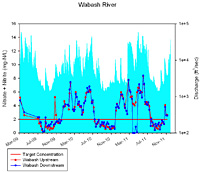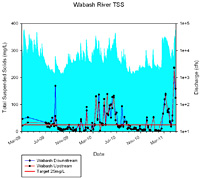Wabash River Survey
Wabash River at North 9th Street, Tippecanoe County, Indiana.
Wabash River at Granville Bridge, Tippecanoe County, Indiana.
Survey Results

Nitrate-nitrogen
Nitrogen is an essential plant nutrient found in fertilizers, human and animal wastes, yard waste, and the air. About 80% of the air we breathe is nitrogen gas. Nitrogen gas diffuses into water where it can be “fixed”, or converted, by blue-green algae to ammonia for their use. Nitrogen can also enter lakes and streams as inorganic nitrogen and ammonia. Because of this, there is an abundant supply of available nitrogen to aquatic systems. The three common forms of nitrogen are:
Nitrate-nitrogen (NO3-N) Nitrate is an oxidized form of dissolved nitrogen that is converted to ammonia by algae. It is found is streams and runoff when dissolved oxygen is present, usually in the surface waters. Ammonia applied to farmland is rapidly oxidized or converted to nitrate and usually enters surface and groundwater as nitrate. The Ohio EPA (1999) found that the median nitrate-nitrogen concentration in wadeable streams classified as warmwater habitat (WWH) was 1.0 mg/l. Warmwater habitat refers to those streams which possess minor modifications and little human influence. These streams typically support communities with healthy, diverse warmwater fauna. The Ohio EPA (1999) found that the median nitrate-nitrogen concentration in wadeable streams classified as modified warmwater habitat (MWH) was 1.6 mg/1. Modified warmwater habitat was defined as: the aquatic life use assigned to streams that have irretrievable, extensive, man-induced modification that precludes attainment of the warmwater habitat use designation; such streams are characterized by species that are tolerant of poor chemical quality (fluctuating dissolved oxygen) and habitat conditions (siltation, habitat amplification) that often occur in modified streams (Ohio EPA, 1999). The U.S. Environmental Protection Agency developed recommended nitrate-nitrogen criterion as part of work to establish numeric criteria for nutrients on an ecoregion basis. The recommended nitrate-nitrogen concentration for the ecoregion is 0.63 mg/l (USEPA, 2000). Nitrate-nitrogen concentrations exceeding 10 mg/1 in drinking water are considered hazardous to human health (Indiana Administrative Code IAC 2-1-6).
Nitrate-nitrogen concentrations in the Wabash River mimic flow conditions with lower nitrate concentrations typically occurring during low flow conditions. Nitrate-nitrogen concentrations indicate no statistical difference between upstream and downstream concentrations. This suggests that Greater Lafayette has no statistical impact on nitrate-nitrogen concentrations.

Total Phosphorus
Phosphorus is an essential plant nutrient and the one that most often controls aquatic plant (algae and macrophyte) growth. It is found in fertilizers, human and animal wastes, and in yard waste. There are few natural sources of phosphorus to streams other than that which is attached to soil particles; there is no atmospheric (vapor) form of phosphorus. For this reason, phosphorus is often a limiting nutrient in aquatic systems. This means that the relative scarcity of phosphorus may limit the ultimate growth and production of algae and rooted aquatic plants. Management efforts often focus on reducing phosphorus inputs to receiving waterways because: (a) it can be managed and (b) reducing phosphorus can reduce algae production. Two common forms of phosphorus are:
Total phosphorus (TP) includes dissolved and particulate phosphorus. TP concentrations greater than 0.03 mg/1 (or 30μg/L) can cause algal blooms in lake systems. In stream systems, Dodd et al., 1998 suggests that streams with a total phosphorus concentration greater than 0.075 mg/L are typically characterized as productive or eutrophic. TP is often a problem in agricultural watersheds because TP concentrations required for eutrophication control are as much as an order of magnitude lower than those typically measured in soils used to grow crops (0.2-0.3 mg/L). The Ohio EPA (1999) found that the median TP concentration in wadeable streams that support WWM for fish was 0.10 mg/L, while wadeable streams that support MWH for fish was 0.28 mg/L. The U.S. Environmental Protection Agency recommended TP criterion for this ecoregion is 0.076 mg/L (USEPA, 2000).
In the Wabash River, total phosphorus concentrations exceed target concentrations 34% of samples upstream of Greater Lafayette and 73% of samples downstream of Greater Lafayette during the sampling period. Concentrations measured downstream of Greater Lafayette typically exceeded concentrations measured upstream of Greater Lafayette with average concentrations measuring 0.1 mg/L and 0.06 mg/L, respectively. This suggests that Greater Lafayette contributed total phosphorus to the Wabash River with larger contributions occurring under high water conditions.

Total Suspended Solids
A TSS measurement quantifies all particles suspended in stream water. Closely related to turbidity, this parameter quantifies sediment particles and other solid compounds typically found in stream water. In general, the concentration of suspended solids is greater during high flow events due to increased overland flow. The increased overland flow erodes and carries more soil and other particulates to the stream. The State of Indiana does not have a TSS standard. In general, TSS concentrations greater than 80 mg/L have been found to be deleterious to aquatic life; concentrations of 15 mg/L are often targeted as levels necessary for quality fishery production (Waters, 1995).
In the Wabash River, total suspended solids concentrations typically mimic flow conditions with the highest concentrations occurring from March to September 2010. In the Wabash River, upstream and downstream total suspended solids concentrations exceed target concentrations 54% and 60% of samples, respectively during the sampling period. No obvious pattern is observable between upstream and downstream samples. This suggests that during some conditions Greater Lafayette contributes suspended sediments to the Wabash River but under different conditions, no contribution occurs.

E. coli
E. coli is one member of a group of bacteria that comprise the fecal coliform bacteria and is used as an indicator organism to identify the potential presence of pathogenic organisms in a water sample. Pathogenic organisms can present a threat to human health by causing a variety of serious diseases, including infectious hepatitis, typhoid, gastroenteritis, and other gastrointestinal illnesses. E. coli can come from the feces of any warm-blooded animal. Wildlife, livestock, and/or domestic animal defecation, manure fertilizers, previously contaminated sediments, and failing or improperly sited septic systems are common sources of the bacteria. The IAC sets the maximum standard at 235 colonies/100 ml in any one sample within a 30-day period.
E. coli concentrations measured in the Wabash River are typically lower than concentrations measured in the tributary streams. Differences in E. coli concentrations between tributary and mainstem sites can be attributed to a number of factors including dilution, lack of direct E. coli sources and inputs, or more periodic direct inputs of E. coli rather than continuous sources as observed in the tributaries. In the Wabash River, upstream and downstream E. coli concentrations exceed target concentrations 33% and 49% of samples, respectively during the sampling period.